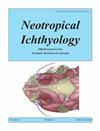巴拉圭河上游流域高地方性水文系统Astyanax种的分子特征(特征:characteridae
IF 2
4区 生物学
Q1 ZOOLOGY
引用次数: 1
摘要
分子工具已被用于提高对淡水新热带鱼类的认识。这些方法支持对包括物种复合体在内的类群的研究,如Astyanax,它是家蚕科中最多样化和分类学最复杂的属之一。本文对巴拉圭河上游流域的4种Astyanax进行了物种划分分析。巴拉圭河上游流域是Mata atlntica东北部的一个高地方性淡水生态区。我们实施了基于两个线粒体和一个核标记的单位点和多位点方法。先前可用的Astyanax物种的细胞色素c氧化酶I序列也被添加到我们的数据集中。单基因座分析表明,长尾拟南毛猴、鲁氏拟南毛猴和鲁氏拟南毛猴为不同的分子操作分类单元(MOTUs),而布鲁库拟南毛猴和洛林拟南毛猴为同一组。然而,多位点方法区分了这两个物种,并显示了其余单位点结果的一致性。利用这两种方法将Astyanax af . rupestris分离为两个MOTUs,表明需要对包括A. af . rupestris在内的Astyanax af . rupestris进行综合分类修订。这些发现有助于更好地了解巴拉圭河上游这一鱼类群体的多样性,识别隐藏的多样性,并加强该水文系统作为鱼系生物多样性地方性研究的重要热点的相关性。本文章由计算机程序翻译,如有差异,请以英文原文为准。
Molecular characterization of Astyanax species (Characiformes: Characidae) from the upper Paraguaçu River basin, a hydrographic system with high endemism
Abstract Molecular tools have been employed to improve the knowledge about freshwater Neotropical fishes. Such approaches supporting studies of groups including species complexes such as Astyanax, one of the most diversified and taxonomically complex genus of the family Characidae. Here, we employed species delimitation analyses in four Astyanax species described for the upper Paraguaçu River basin, a drainage within Northeastern Mata Atlântica freshwater ecoregion with high endemism. We implemented single and multilocus approaches based on two mitochondrial and one nuclear markers. Cytochrome c Oxidase I sequences previously available for Astyanax species were also added to our dataset. The single locus analyses showed A. epiagos, A. rupestris, and A. aff. rupestris as different Molecular Operational Taxonomic Units (MOTUs), while A. brucutu and A. lorien were grouped. However, the multilocus approach distinguished these two species and showed congruence for the remaining single locus results. Astyanax aff. rupestris was separated into two MOTUs using both approaches, highlighting the need for an integrative taxonomic revision including A. aff. rupestris. These findings contribute to a better understanding of the diversity of this fish group in the upper Paraguaçu, identifying hidden diversity and reinforcing the relevance of this hydrographic system as a notable hotspot for ichthyofauna biodiversity endemism.
求助全文
通过发布文献求助,成功后即可免费获取论文全文。
去求助
来源期刊

Neotropical Ichthyology
生物-动物学
CiteScore
2.80
自引率
17.60%
发文量
24
审稿时长
6-12 weeks
期刊介绍:
Neotropical Ichthyology is the official journal of the Sociedade Brasileira de Ictiologia (SBI). It is an international peer-reviewed Open Access periodical that publishes original articles and reviews exclusively on Neotropical freshwater and marine fishes and constitutes an International Forum to disclose and discuss results of original research on the diversity of marine, estuarine and freshwater Neotropical fishes.
-Frequency: Four issues per year published only online since 2020, using the ‘rolling pass’ system, which posts articles online immediately as soon as they are ready for publication. A searchable and citable Digital Object Identifier (DOI) is assigned to each article immediately after online publication, with no need to await the issue’s closing.
-Areas of interest: Biology, Biochemistry and Physiology, Ecology, Ethology, Genetics and Molecular Biology, Systematics.
-Peer review process: The Editor-in-Chief screens each manuscript submitted to Neotropical Ichthyology to verify whether it is within the journal’s scope and policy, presents original research and follows the journal’s guidelines. After passing through the initial screening, articles are assigned to a Section Editor, who then assigns an Associate Editor to start the single blind review process.
 求助内容:
求助内容: 应助结果提醒方式:
应助结果提醒方式:


